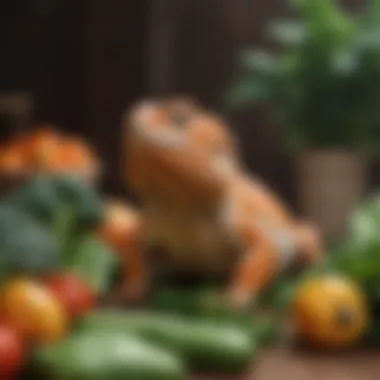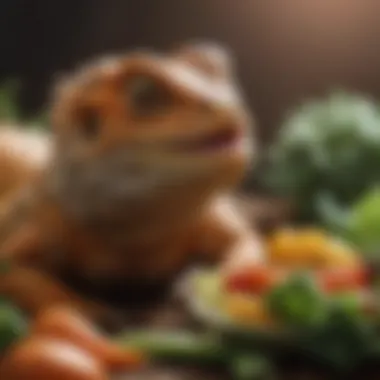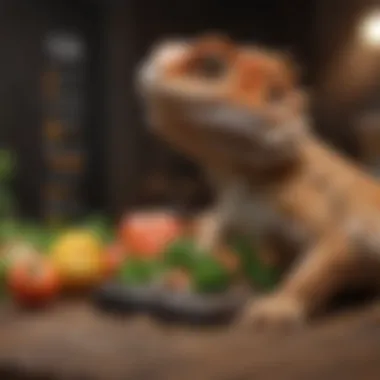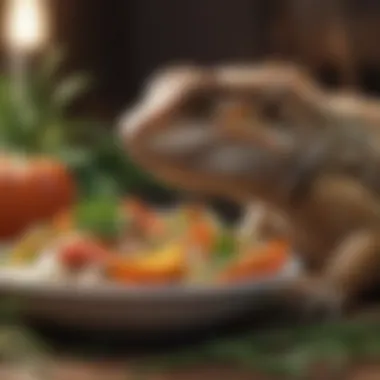Understanding the Crucial Role of Vegetables for Bearded Dragons


Intro
Bearded dragons are captivating reptiles, known for their calm demeanor and distinct appearance. However, their health and well-being heavily depend on proper diet, which includes a variety of vegetables. The objective of this article is to highlight the significance of incorporating vegetables into a bearded dragon's diet. By understanding their nutritional needs and preferences, owners can take proactive steps to enhance their pet's health. This section lays the groundwork for a comprehensive exploration of bearded dragon care, emphasizing how vital vegetables are in achieving a balanced diet.
Animal Overview
Common Names
The bearded dragon, commonly referred to as “beardie,” is a popular choice of pet among reptile enthusiasts. Other lesser-known names include the inland bearded dragon, central bearded dragon, and the eastern bearded dragon.
Scientific Classification
Bearded dragons belong to the family Agamidae. Their scientific name is Pogona vitticeps. This classification illustrates their connection with other lizard species.
Geographic Range
Originally native to Australia, bearded dragons inhabit various environments, including deserts, woodlands, and scrublands. They are adaptable creatures, thriving in diverse habitats, which influences their dietary habits. Understanding their origins can help owners replicate an ideal home setting, essential for maintaining health.
Importance of Vegetables
Vegetables are fundamental to the bearded dragon's diet as they provide essential vitamins, minerals, and fiber. These nutrients are crucial for digestion, bone health, and overall vitality. A balanced diet is not just beneficial but necessary for their well-being.
Nutritional Requirements
Bearded dragons require a proper balance of protein, carbohydrates, and fat in their diet. Vegetables fulfill the carbohydrate and fiber needs effectively. It is important to choose vegetables that provide vitamins A, C, and K, as these play important roles in maintaining skin health and boosting the immune system.
Suitable Vegetable Options
- Collard Greens: High in calcium and vitamins.
- Dandelion Greens: A great source of antioxidants.
- Butternut Squash: Offers both vitamins and carbohydrates.
- Zucchini: Hydrating and low in calories.
Each option contributes different beneficial components essential for health. Variety is key to providing a well-rounded diet.
Preparation Methods
How owners prepare vegetables can greatly affect palatability and nutrient retention. It is advisable to wash vegetables thoroughly to remove pesticides. Cutting them into small pieces makes it easier for bearded dragons to eat. Some vegetables are best served raw, while others can be steamed lightly to soften them.
Role of Vegetables in Digestive Health
Vegetables play a significant role in promoting healthy digestion for bearded dragons. Fiber helps to maintain proper gut motility and prevents constipation. A well-functioning digestive system is crucial as it ensures that nutrients can be absorbed efficiently.
Understanding Bearded Dragons
Bearded dragons are captivating reptiles native to Australia. Comprehending their biology and natural behavior is essential when considering their dietary needs. This knowledge allows owners to tailor feeding practices that promote health and vitality. The focus on vegetables in their diet cannot be overstated, as they play a significant role in providing necessary nutrients, ensuring proper digestion, and enhancing overall well-being.
Overview of Bearded Dragons
Bearded dragons belong to the genus Pogona, and there are several species. They are known for their distinct appearance, characterized by a flattened body and a beard-like structure under their chin. Typically, their coloration ranges from brown to yellow, and these reptiles can grow quite large, reaching lengths of over two feet.
In captivity, bearded dragons can develop various personalities and are often social and friendly. Understanding their behavior, including basking in heat and seeking shelter, is crucial for their care. They thrive in environments that mimic their natural habitats, which greatly influences their dietary habits.
Natural Habitat and Diet
In the wild, bearded dragons inhabit arid and semi-arid regions. Their natural diet consists of a combination of insects, small animals, and various plant materials. This omnivorous diet is critical for their survival, as it provides them with essential nutrients necessary for growth and health.
Vegetables make up a part of their diet, particularly in locations rich with flora. Key components include leafy greens and other non-leafy vegetables. These plants supply vitamins and minerals that are vital for metabolic functions. However, it is important for pet owners to consider the specific needs of their bearded dragons when recreating their natural diet, factoring in age, size, and specific health conditions.


Understanding the natural diet of bearded dragons is imperative, as it provides valuable insight into their nutritional requirements, especially the importance of incorporating a variety of vegetables.
Nutritional Needs of Bearded Dragons
Bearded dragons require a balanced diet to thrive. Understanding their nutritional needs is crucial to providing a healthy and active life for these reptiles. Their diet needs to include various components, primarily focused on vitamins and minerals, which are essential for their growth and overall well-being. This section explores the core nutritional elements that must be included in the diet of bearded dragons, examining how the right balance can promote health and longevity.
Essential Nutrients
A bearded dragon's diet should offer a mix of proteins, fats, carbohydrates, vitamins, and minerals. Each plays a role in maintaining their physiological and mental health. Here are the essential nutrients:
- Proteins: Vital for growth and tissue repair, proteins come from insects and some plant sources.
- Fats: Needed in small amounts for energy, fats come from animal sources primarily.
- Carbohydrates: They provide energy but should come mainly from vegetables and fruits.
- Vitamins: Especially vitamin A, vitamin D3, and essential B vitamins are crucial for metabolic functions.
- Minerals: Calcium and phosphorus need to be monitored closely to prevent metabolic bone disease. A 2:1 ratio of calcium to phosphorus is ideal.
Owning a bearded dragon means more than just providing them food; it involves carefully considering their nutritional intake to ensure they receive what they need.
Role of Vegetables in Their Diet
Vegetables form an essential part of the bearded dragon's diet, contributing to their overall health rather than being just filler food. While they are herbivores as adults, the inclusion of a variety of vegetables enhances their nutritional intake.
Benefits of vegetables include:
- Hydration: Many vegetables are high in water content, assisting in hydration, which is critical for digestion.
- Fiber: Fiber from vegetables supports digestive health and prevents impaction.
- Vitamins and Minerals: Different vegetables supply a plethora of vitamins and minerals, particularly calcium, magnesium, and potassium, vital for metabolic functions.
Whether it's leafy greens like kale and collard greens, root vegetables such as carrots or non-leafy choices like bell peppers, each carries unique benefits.
Bearded dragons benefit greatly from a varied diet rich in vegetables, aiding in preventing nutritional deficiencies and promoting gut health.
Choosing the Right Vegetables
Choosing the right vegetables for bearded dragons is essential for maintaining their health and well-being. This section highlights various vegetables that benefit these reptiles in different ways. It is important to consider factors such as nutrient content, availability, and freshness when selecting vegetables. A proper mix of different types ensures not only nutritional balance but also encourages natural foraging behavior.
Leafy Greens
Leafy greens are a significant part of a bearded dragon's diet. They provide essential vitamins and minerals. Common options include collard greens, kale, and dandelion greens. These vegetables are high in calcium, which is crucial for bone health. Not all leafy greens are equal. Some have higher oxalate levels, which can bind calcium and hinder absorption. Thus, it is important to rotate greens to avoid potential imbalances. Additionally, leafy greens can be offered in a chopped form, making them easier for the lizard to consume.
Root Vegetables
Root vegetables add variety to a bearded dragon's diet. Carrots and sweet potatoes are popular choices. These vegetables are rich in beta carotene, converting to vitamin A in their bodies. Vitamin A is important for vision and immune function. While root vegetables offer good nutrition, they should be given in moderation. High starch content can lead to obesity if fed too often. Always ensure that these vegetables are offered in manageable sizes.
Non-leafy Vegetables
Non-leafy vegetables, such as bell peppers and squash, are also beneficial. They provide hydration and additional vitamins. Bell peppers, for instance, are high in vitamin C while squash can offer a good source of fiber. As with other vegetables, freshness is key. Look for vibrant colors and a firm texture to ensure the best quality. It is important to introduce these vegetables gradually to monitor for any dietary sensitivities or preferences.
The right choice of vegetables is about diversity. A good mix helps replicate their natural foraging behavior and supports better health.
Preparing Vegetables for Bearded Dragons
When it comes to ensuring a balanced diet for bearded dragons, preparing vegetables properly plays a crucial role. It is not just about what vegetables are included but how they are prepared. Proper preparation can enhance the nutritional value that these reptiles obtain from their food. This section addresses the significance of preparation and offers practical tips for bearded dragon owners.
Washing and Cutting
Cleaning vegetables before serving is essential. As bearded dragons are sensitive to pesticides and dirt, washing eliminates these potentially harmful substances. Use clean water to rinse vegetables thoroughly. This process should include:
- Soaking: Allow the vegetables to soak for a few minutes in cool water.
- Rinsing: Rinse under running water to remove residual dirt.
- Cutting: After washing, cut the vegetables into appropriately sized pieces. Bearded dragons may struggle with larger chunks. The size of the pieces should be manageable to avoid choking.
In addition to cleanliness, cutting also allows for better digestion. Smaller pieces can be metabolized more easily by the reptile’s digestive system. This can lead to improved nutrient absorption and overall health.


Cooking vs.
Raw
Deciding between raw and cooked vegetables can impact the dietary quality for bearded dragons. Raw vegetables often retain more nutrients, which supports a thriveing creatures. However, some vegetables may have tough textures that could make them less appealing. Cooking vegetables can soften them, making it easier for dragons to manage.
Consider the following when choosing between raw or cooked:
- Nutritional Value: Raw vegetables often offer more vitamins. For many bearded dragons, a mix of both raw and lightly cooked vegetables can provide a more balanced intake.
- Digestibility: Cooking can break down tough fibers in some veggies, enhancing digestibility. This can be beneficial for older or sick dragons.
- Variety: Offering a combination can be stimulating and encourage feeding. Keeping a variety ensures that dragons receive a broad spectrum of nutrients.
Storage Considerations
Proper storage of vegetables ensures their longevity and nutrient retention. It's important to consider:
- Refrigeration: Most vegetables should be stored in the refrigerator to maintain freshness. Make sure to keep them in sealed containers or plastic bags to prevent spoilage.
- Short Shelf Life: Leafy greens have a shorter shelf life compared to root vegetables. Regularly check for signs of decay and remove any spoiled items.
- Pre-prepped Veggies: If you batch prepare vegetables, be mindful of how long they can be stored. Typically, pre-cut or washed vegetables should be consumed within a week.
To conclude, the preparation of vegetables is a fundamental aspect of feeding bearded dragons. By washing, cutting, and deciding between raw and cooked options, owners can significantly improve the quality of the diet. Additionally, proper storage practices can prolong freshness, ensuring that your bearded dragon receives the nutrients required for optimal health.
Feeding Strategies
Understanding the right feeding strategies for bearded dragons is essential for their health and well-being. Each dragon is unique, and tailoring their diet to individual needs can yield significant benefits. Proper feeding strategies help ensure that a bearded dragon receives the appropriate nutrition, prevents dietary-related health issues, and promotes longevity. Here's a detailed look at key components of feeding strategies.
Frequency of Feeding
The frequency of feeding is crucial in maintaining a balanced diet. Young bearded dragons generally require more frequent meals than adults. For hatchlings and juveniles, feeding should happen daily, sometimes multiple times a day. They use more energy and grow rapidly, thus needing adequate food sources. As they mature into adults, feeding can reduce to every other day. Adult bearded dragons tend to have a slower metabolism and lower energy needs. Understanding these intervals helps in adapting feeding schedules to the dragon’s growth stage and overall health.
Additionally, it's essential to observe behavior during feeding. If your bearded dragon consistently shows a lack of interest in food or leaves vegetables untouched, you may need to reassess. Factors influencing feeding frequency include age, health, and even seasonal changes. Regularly monitor your dragon’s behavior for signs of hunger.
Portion Sizes
Portion sizes also play a significant role in ensuring healthy eating for bearded dragons. Vegetables should comprise a substantial part of their diet, but the serving size must be appropriate. It’s good practice to offer a variety of vegetables while ensuring that portions are aligned with their size and age. A general guideline is to provide a meal portion that is about the size of the space between the dragon's eyes.
Overfeeding can lead to obesity, which poses health risks. Therefore, it's wise to start with smaller portions. An adult bearded dragon may consume about one cup of mixed vegetables per day, whereas juveniles may need around half that amount. Monitor their weights regularly, and adjust portions if necessary. Maintaining a proper balance is key to fostering optimal health.
Mixing with Other Food Sources
Mixing vegetables with other food sources is a useful strategy to enhance nutrition. Bearded dragons require a diverse diet that includes proteins, particularly as juveniles. While vegetable intake is important, incorporating insects such as crickets, mealworms, or roaches into their diet ensures sufficient protein levels. These insects can provide vital amino acids that vegetables do not offer.
When. creating meals, consider the balance of both vegetables and proteins. It's often recommended to feed insects first and then offer vegetables afterward to prevent a mess during feeding. This way, the dragon is inclined to consume both food types effectively. Additionally, rotating different kinds of vegetables and insects can keep their diet interesting and nutritionally diverse. It’s important to avoid always mixing everything. Instead, separate meals of insects and vegetables by a few hours or even offer them on different days.
By combining proteins and vegetables, you not only keep your bearded dragon engaged but also ensure they receive a comprehensive range of nutrients essential for health.
Common Mistakes to Avoid
Understanding the dietary needs of bearded dragons is crucial, but so is recognizing the common mistakes that can undermine their health. By identifying these pitfalls, caregivers can improve the overall well-being of their pets. The following sections detail what these mistakes are and how to avoid them for better nutrition.
Over-reliance on Vegetables
Bearded dragons are omnivores, meaning their diet should contain both plant and animal sources. A common mistake many owners make is overly relying on vegetables. While vegetables are essential, they must not make up the entirety of the diet. A diet excessively rich in vegetables can lead to imbalances. For instance, bearded dragons need protein for growth and overall health, which they can get from insects and other animal sources. Too many vegetables can also diminish the intake of certain critical nutrients. It is vital to maintain balance; as a rule, vegetables should comprise only a portion of a bearded dragon's diet, alongside proteins and fruits.
Ignoring Nutritional Balance
Another significant mistake relates to ignoring the overall nutritional balance in a bearded dragon's diet. Not all vegetables offer the same benefits. Some might be low in vital nutrients like calcium or vitamins A, D, and E. If the focus is solely on one type of vegetable, nutritional deficiencies can occur. For example, feeding only iceberg lettuce may lead to a lack of necessary nutrients because this leafy green has very little nutritional value. Instead, it is crucial to include a variety of vegetables, ensuring that the bearded dragon receives a mix of essential nutrients. This balance promotes healthier growth, better coloration, and enhanced vitality.
Feeding Inappropriate Foods


Feeding inappropriate foods can have severe consequences for the health of bearded dragons. Some vegetables and fruits are toxic or can cause digestive stress. Foods like avocado, garlic, and certain types of rhubarb should be avoided. Even seemingly harmless treats can lead to issues if they are not properly vetted. Misunderstanding what is safe can stem from assuming that all natural foods are acceptable. Always conduct research or consult a veterinarian before introducing new items into a bearded dragon's diet. Proper food selection is essential for preventing health issues caused by unsuitable foods.
Always ensure a well-rounded diet for your bearded dragon, with careful attention to the variety of foods offered.
Monitoring Health and Behavior
Monitoring the health and behavior of your bearded dragon is critical to ensuring its well-being. The proper diet, which includes a variety of vegetables, plays a vital role in this aspect. Vegetables not only provide essential nutrients but also impact the overall behavior and health. Observing changes in eating habits, energy levels, and physical appearance can provide crucial insights into your pet's health status.
Regular monitoring allows you to catch potential issues early. It is essential to check for signs of adequate hydration, alertness, and normal activity levels. A bearded dragon that is lethargic or not eating may indicate dietary deficiencies or other health concerns that warrant immediate attention. Furthermore, understanding typical behavior patterns helps identify when something is amiss.
There are specific elements to observe:
- Dietary intake: Timely tracking of what and how much your dragon consumes.
- Bowel movement: Healthy feces can indicate a well-balanced diet.
- Skin condition: Look for shedding issues or discoloration which can signal dehydration or nutritional imbalance.
By keeping a close watch on these factors, pet owners can adjust diets or seek veterinary help when necessary. A proactive approach in monitoring your bearded dragon's health based on its dietary habits is essential to maintaining its longevity and quality of life.
Signs of a Healthy Bearded Dragon
A healthy bearded dragon shows several clear signs. Physical appearance, behavior, and activity levels serve as key indicators.
Physical Appearance
- Vibrant colors: A healthy dragon exhibits bright and vivid colors, which can indicate good health and proper nutrition.
- Clear eyes: Eyes should be bright and clear, without discharge or swelling.
- Fullness: Adequate muscle tone and body weight reflect a balanced diet.
Behavior
- Active and curious: A healthy bearded dragon is typically active and interested in its surroundings. If your pet interacts and explores, it indicates well-being.
- Normal appetite: Consistent eating habits suggest a proper diet.
- Regular basking: Spending time under heat lamps is a sign of good thermoregulation.
Regular monitoring of these signs can prevent chronic health issues later on.
Identifying Dietary Issues
Identifying dietary issues early on is crucial for the health of a bearded dragon. A diverse diet, particularly vegetables, is essential; however, imbalances can arise. Certain symptoms may suggest that your dragon is not receiving the proper nutrition.
Common Indicators
- Weight loss: Significant or sudden weight loss can indicate inadequate nutrient intake. This is concerning and warrants immediate dietary evaluation.
- Sequence of shedding: An abnormal shedding process may stem from nutritional deficiencies.
- Digestive problems: Signs such as diarrhea or constipation can be directly linked to diet. It is important to assess what is being fed.
Behavioral Changes
- Lethargy: Behavior that is less active than usual may signal vitamins or minerals shortfalls.
- Aggression or stress: Changes in disposition can indicate an underlying health issue, potentially stemming from dietary problems.
Finale
The conclusion serves as the final synthesis of the entire discussion on the dietary needs of bearded dragons, particularly the role of vegetables. Understanding the importance of this subject is crucial for ensuring the optimal health of these reptiles. Vegetables provide essential nutrients that are vital to the growth, development, and overall well-being of bearded dragons.
In this article, several key elements were covered that underscore the significance of including vegetables in their diet. The understanding of their nutritional requirements helps owners make informed choices. It is also important to recognize the variety of suitable vegetables and preparation methods that can enhance palatability.
The balance of a bearded dragon’s diet greatly influences their health and longevity.
The article also emphasized the importance of monitoring health and behavior to identify any dietary issues, allowing for timely adjustments. Ultimately, this conclusion ties everything together, reinforcing how thoughtful vegetable inclusion in their diet can lead to improved health outcomes.
Summary of Key Points
The following points encapsulate the critical themes discussed:
- Nutritional Needs: Bearded dragons require a varied diet that includes nutrients provided by vegetables, such as vitamins and fiber.
- Vegetable Selection: Certain vegetables are more beneficial than others. Leafy greens, root vegetables, and non-leafy varieties should all be considered.
- Preparation Matters: Washing, cutting, and sometimes cooking vegetables can enhance their benefits and keep them safe to eat.
- Feeding Strategies: The way vegetables are offered—like frequency and portion sizes—plays a role in their diet's overall effectiveness.
- Common Mistakes: It's easy to over-rely on vegetables or ignore the need for a balanced diet, which can lead to health issues.
- Monitoring: Keeping an eye on a bearded dragon’s health can provide early warnings of any dietary deficiencies.
Final Thoughts on Vegetable Nutrition
Choosing the right vegetables and preparing them correctly adds another layer of care that an owner can provide. As a result, bearded dragons can thrive in captivity, mimicking their natural dietary habits as closely as possible. For anyone who is a bearded dragon enthusiast, prioritizing vegetable nutrition should be an integral part of their care routine.
Ultimately, a well-balanced diet that highlights the importance of vegetables leads to a happier and healthier bearded dragon, reflecting the bond between the pet and its owner.







